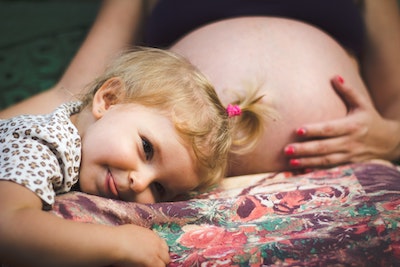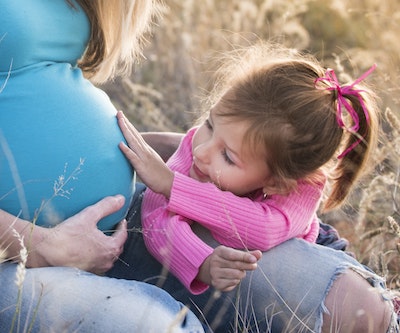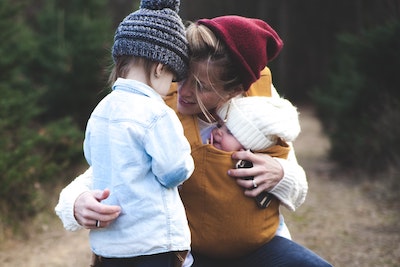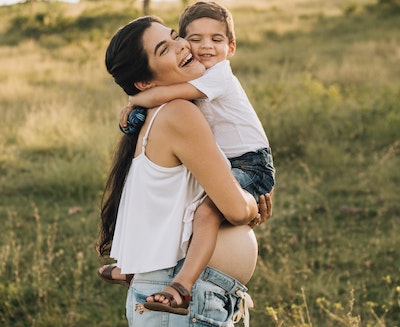The birth of a second baby brings yet another bundle of joy at home. And it’s such a beautiful experience for mom and dad.
This is especially because it comes with way less stress and anxiety compared to the first pregnancy.
But not everyone in the family views the new baby from your point of view.
Ask your firstborn.
Having enjoyed all the attention and affection that comes with being the only one, the arrival of another sibling comes as a life-changing event that could steer things in any direction.

Jealous Or Joyous?
As first time parents who are either preparing for or have just welcomed their second baby, it’s natural to wonder how the older kid will receive the “good news”.
As you’ll soon find out in a couple of minutes, there are a whole lot of possibilities here and different children will react differently; either positively (joyous) or negatively (jealous).
But whichever direction things go depends on your child’s individual personality, how prepared he/she is for the second child, and most importantly, how you treat them after the newborn baby arrives.
It’s very important that you pay close attention to how your firstborn reacts to your interactions with the second child during the first weeks. This is because, in addition to helping you to gauge their acceptance of the infant, their initial reaction highly predicts their behavior several months after the birth of the second child.
Early identification of negative responses may allow a family practitioner to intervene and curb potentially problematic sibling relationships several years down the line.
| Would you like to read more articles about pregnancy, parenting and my tips for parents? Browse around my website. |
Firstborn’s Different Responses To A Second Born & Change In Behavior
There are lots of studies that have been carried out to determine firstborn’s behavior in response to the interaction between the mother and the infant.
This 2014 study1 published in the National Institutes of Health employed the largest sample so far. In addition to being the biggest, it also brings a unique aspect; the inclusion of fathers.
The participants in this study were 241 families comprising of mothers, fathers, and dads. These families were primarily
European American, earning $60,000-$99,999, and were expecting their second child.
The expectant mothers were recruited from obstetric clinics, and through advertisements and flyers posted in pediatrician offices, local hospitals, and childbirth classes.
The researchers in this study had 3 main aims:
- To determine whether firstborns exhibit different behavioral profiles in response to mom-infant interaction
- Examining the sibling’s problem behaviors at 1 and 4 months following the arrival of the new baby
- Examine whether the child’s attachment security before the arrival of the infant could be linked to their jealousy profiles
The research was done in 5 measurement occasions starting from the last months of pregnancy, and then in the 1st, 4th, 8th, and 12th months after the infant’s birth.

Results & Discussion
This study affirms previous research findings that children react differently to the arrival of a new baby and the behaviors may be either negative or positive.
The researchers, however, went ahead to uncover several classes of behavioral reactions based on how the children appraised the emerging affection interaction between parent and sibling.
Regulated-Exploration Group
This class was the largest and comprised 60% of the children involved in the study. These kids monitored the interaction between parent and infant closely and often sat by quietly while freely exploring their toys. However, they would sometimes make some social positive approaches and also try to join the interaction at times but they didn’t portray any disruptive behaviors.
This finding was in line with other US studies’ suggestion that most kids draw a lot of confidence from their parent’s accessibility and use that as a secure base to explore around.
Importantly, kids in this group were reported to have the fewest problem behaviors compared to other children several months later.
Approach-Avoidant Group
This group was the second largest at 30%. Kids in this class displayed high levels of monitoring and relatively lower exploration levels compared to the regulated-exploration group. Approach-avoidant also portrayed a lower amount of social approach and sought very little attention and comfort from the parent.
In addition, these kids were also a little bit more disruptive than the first group and also had the highest scores on most problem behaviors including aggression, sleep, withdrawal, and emotional reactions 4 months after the new baby’s arrival.
The researchers argued that Approach-avoidant kids had a higher internalizing and externalizing behavior that led to keen monitoring of parent-infant interaction, impoverished solitary play, and reduced approach to the parent-infant interaction.
They say that the initial withdrawal is probably what led to difficult sibling relationships a year later.
Therefore, the researchers highly recommend identifying these children early enough and intervening to prevent problematic sibling relationships later in life.
Disruptive-Dysregulated Group
The siblings in this group distinguished themselves from the rest by their high level of monitoring parent-infant interaction much more closely. There were also attempts to seek attention and also sought comfort by approaching the interaction socially.
Surprisingly, disruptive-dysregulated children were reported to portray more attention and aggression problems in addition to being more emotionally reactive after 4 months.
The researchers state these kids are at the highest risk of externalizing behavior problems and regulating negative emotions in the future. Therefore, they call upon parents and family practitioners to attend to them very closely.
Anxious-Clingy Group
This was the second smallest group (6%) and it monitored the mother-infant interaction more intently than all the other groups.
They also frequently attempted to seek comfort actively or join the interaction positively. Physical disruptions and protesting against the parent-infant interaction also ensued albeit not as frequent as that of disruptive children. All of these led to very low levels of free exploratory plays.
A significant finding here was that most of the kids who fell in this class were younger than those in the approach-avoidant group but of the same age to those in the regulated exploration class.
The presumption here was that the need for constant close proximity and contact might have been as a result of their young age.
Attention-Seeking Group
Contrast to previous studies, this study didn’t find solid evidence to affirm that that firstborn kids tend to be more jealous towards father-infant interaction than mother-infant interaction.
However, the inclusion of fathers led to the emergence of another class of attention-seeking siblings as a response to father-infant interaction. This group didn’t emerge with the mothers.
Attention-seeking siblings spent a sizable amount of time monitoring father-infant interaction. A unique aspect of this group, however, was its high level of attention-seeking and positive approach to join the interaction.
Fathers also reported that this group had low scores on most of the problem behaviors.
In a bid to uncover why the attention-seeking group emerged with the fathers and not the mothers, the researchers argued that this is because fathers are usually not as tolerant to children’s physical clinging and distress as their mothers, and often resort to punishing negative emotions.

How To Prepare Your Firstborn To The New Baby
The idea of another baby joining your firstborn’s mom-centric world will elicit mixed reactions to you as the parent, and to your firstborn as well.
While they may not perfectly understand what it is like to have another baby sister or brother especially at year 1, the reality is they can detect that there are some major changes coming.
The important thing, therefore, is to help them handle the changes positively2 as opposed to feeling displaced by baby number two.
Let Them Be Among The First People You Tell About Your Second Pregnancy
You see, the sooner you tell your firstborn about the new baby growing in your bump, the more time they’ll have to prepare mentally. And this helps greatly in minimizing the shock that may arise with the arrival of the second child.
Besides, even though babies can’t “sense” that mommy is pregnant, they use lots of cues to tell something is about to change (they see mom’s body is changing, her changes in mood, her getting new stuff for the baby etc.).
Of course, how you break the big new sibling news will depend on their age3. For instance, your 1-year-old probably won’t understand a thing and will very likely go on with his exploration plays. But pointing to your belly and telling him “baby” and even inviting him to feel the kicks at month 6 and singing together for the baby will start creating some leads.
Preschoolers – ages 2-4 years – are more likely to understand what it is to have someone else come between them and mom and dad. And they won’t be ready to share you yet. So, wait till they start seeing your “growing stomach” and when you start shopping nursery furniture before breaking the news. Ensure that they get the news from you first, though.
Make It Exciting
Your older child’s world will change completely once the new baby arrives. The easiest way to ensure that it will be exciting then is to make it exciting now – and there’s no better way to do this than by letting him/her connect to the baby4.
To begin with, show them their pictures in mummy’s tummy and how they looked in their infancy. If you have some ultrasound photos, use them to explain the development of their new brother/sister in your belly.
You could also consider visiting friends who have an infant at this time. Spend some time holding the baby while still showing a lot of love to your child will help them understand that you’ll still love and care about them when the new sibling comes.
In addition, involve your child in active preparations for the baby. Take them with you when shopping for baby’s clothes and actually let them pick out what they’d like for their baby bro or sis.
Importantly, discuss the potential baby names you’re nodding. Referring the baby with the name that you’ve all agreed to when talking to them and feeling the kicks on your belly will make this whole journey much clearer.

How To Treat Your Older Child When The Baby Arrives
The arrival of the new baby will bring with it tons of joy and one huge challenge – helping the older kid embrace the baby and welcome him/her to her specialness.
What you need to do at this time is to let the only one understand that he/she isn’t being displaced at all. To do this, create a feeling of ownership by referring the newborn as “our baby”, “your baby” or “your brother”.
You could also give him/her some active roles in caring for the baby, for instance, asking him to tell the baby to stop crying or come with you as you change or bathe the infant.
In addition, keep reminding him/her what a great child he/she is and how grateful you are when he/she is helping you around.
Doing this will help them understand that they are the big sister or big brother now and thereby develop an affectionate relationship with the infant.
Perhaps what’s even more important is sparing some time to be with the older child and playing around with them. This is where dad and grandparents come into the picture.
Spending a healthy one-on-one time with the older child will compensate the time that you are constantly holding the infant and will reassure them that they are still very special in the family even with the arrival of the new baby.
On the same note, remind your friends and relatives to get the older child some gifts as they visit the infant and also spend some time with him/her. This way, he/she won’t feel left out in the excitement.

How To React To Children Jealousy And Rivalry
Naturally, the arrival of the new baby and everything about it will cause the older kid some stress which will be manifested in the form of jealousy5.
At this time, they feel that their world has caved in on them now that they are no longer the family’s center of attention.
While they may resort to certain weird behaviors just to attract your attention, there are things that they totally lack control of, for instance, regression. Be ready for frequent toilet accidents, wetting the bed, whining a lot, thumb-sucking, and inability to locate pajamas without mom’s hand.
There are also times when they’ll say hurtful things like “I HATE that baby” or “Take him back to the hospital”. They might even get physical with you and even the baby.
More often than not, relatives and friends will take it that you’re being too soft on them and that they need punishment to act their age.
But then again, keep in mind that your firstborn will use your actions to determine whether to consider the baby as a threat or a friend.
Understand that this is more or less a rite of passage that all firstborns go through and you aren’t a bad parent at ll.
What the child needs right now isn’t punishment, but more of your understanding and a little comfort. Depending on their age, you could hold a friendly meeting and let talk it out. Ask them how they feel about the baby and listen with intent to help.
Don’t insist that they get affectionate with the baby immediately. This will come with time as you teach them on how best to interact with the baby and how to express their feelings.
Bibliography:
Volling, Brenda L., et al. “Children’s responses to mother–infant and father–infant interaction with a baby sibling: Jealousy or joy?.” Journal of Family Psychology 28.5 (2014): 634. DOI: 10.1037/a0037811
Other sources:
https://www.psychologytoday.com/
https://www.whattoexpect.com/
https://www.todaysparent.com/
https://www.babycentre.co.uk/
Please keep in mind that this article IS NOT a medical advice. The purpose of this article is informative and it should NOT be used as a substitute for consultation with a doctor. Always consult your health concerns and decisions with your doctor.

